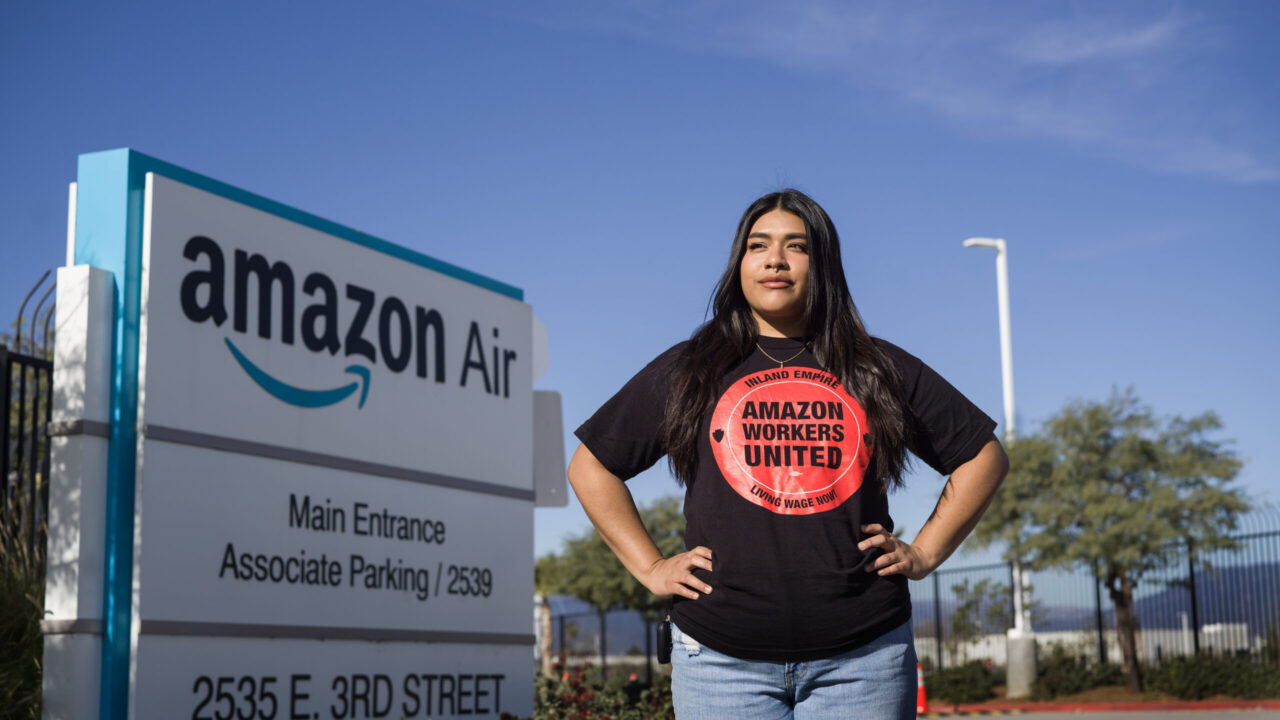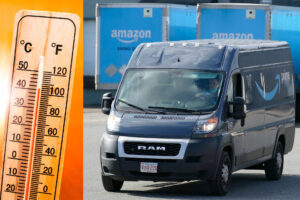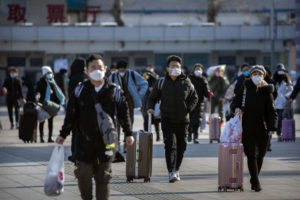How Solidarity Got Amazon Workers a Raise Before a Union
Two Christmas rushes ago, workers at this Amazon air cargo hub started to win improvements at work by relying on each other. Anna Ortega outside the Amazon Air facility in San Bernardino, CA. Photo: Barbara Davidson, courtesy of Capital & Main
Anna Ortega outside the Amazon Air facility in San Bernardino, CA. Photo: Barbara Davidson, courtesy of Capital & Main
The Christmas rush has a way of clarifying things for Amazon workers.
Samantha Martin, a 24-year-old employed at Amazon’s San Bernardino “air hub” outside Los Angeles, still remembers her first Christmas at the job in 2021. Two weeks before the holiday, Amazon announced that the facility, known as KSBD, would close intermittently over four days. Essentially a loading dock for planes, the hub employs around 1,800 people at peak, and was the company’s third largest air hub in the U.S. as of 2022. The workers, whose initial starting wage of $15 an hour was equivalent to an annual, full-time income of $30,000, were suddenly faced with losing nearly a week of pay.
A handful of workers, Martin included, decided they’d had enough. “Almost everyone is living paycheck to paycheck,” said Martin. “You can’t really have unexpected changes to your money like that.” People shared the story of a co-worker losing her apartment when she couldn’t pay the rent that month, then moving into her car. They gathered about 200 signatures on a petition demanding back pay and limits to holiday closures. Thirty workers handed it to a general manager in person.
The shutdown went on as planned, and the workers never got back pay. But in February 2022, they achieved something of a victory: Amazon announced that future December holidays would go unpaid for only one day — across the company’s U.S. air hubs. At KSBD, the company expanded overtime hours, enabling workers to make up lost income.
The workers were elated — and, notably, called themselves an organizing committee, rather than a labor union. Like workers at nearly all of Amazon’s 1,334 facilities across the country, the KSBD workers have no formal affiliation with an existing union. And yet that holiday-fueled protest was also just the beginning of one of the country’s most successful efforts to improve jobs at Amazon, union or not.
* * *
After the 2021 victory, workers felt optimistic. “That was a really big win. Like, I saw that we could get a national policy changed,” said Martin. The work paid more, and more consistently, than Martin’s earlier jobs, mostly waiting tables and working in kitchens. But the work was grueling, too: sorting sacks of packages that shot down to the foot of a chute at breakneck pace, or maneuvering one- and two-ton freight loaders across the warehouse floor — a wall-to-wall grid of tiny wheels called a “caster deck.” When Amazon budged on that first holiday demand, it was a sign that change was possible, said Martin. “I was like, ‘OK, what else can we do with this?’”
Martin had never worked in a unionized workplace. Neither had her parents: a private-school teacher and a restaurant worker. She says she and her co-workers weren’t against forming a union. But they didn’t know much about unions, either. They weren’t sure they needed to take that step yet. “We need a lot of power to win a union at Amazon,” said Martin.
They gathered about 200 signatures on a petition demanding back pay and limits to holiday closures. Thirty workers handed it to a general manager in person.
Indeed, because federal labor laws provide little protection for union organizing, many workers seek to improve conditions first. At KSBD, support for the organizing effort grew when the petition actually made workers’ jobs better.
Co-workers had approached Anna Ortega about signing the petition, but Ortega, then 22, had shook her head no. “I just wanted more money,” said Ortega — her signing bonus had been nearly double what she’d made in a month at her last job, running the register at a pawn shop. At Amazon, she even hoped for a promotion and a raise. “I [didn’t] want to jeopardize my chances,” she said.
With the new changes, Ortega began to wonder if those “chances” were worth her silence. After all, she and a lot of her co-workers “made a lot of extra money” with the extra time off. Amazon hadn’t offered that freely; her co-workers had had to demand it.
Ortega joined the small group of workers beginning to spread the word however and wherever they could: outside KSBD, in break rooms, passing out flyers. One worker knew someone who worked at the Warehouse Worker Resource Center, a decade-old offshoot from an earlier union federation. Workers at KSBD began to meet with organizing staff there in February 2022, thinking about what they might do. They started calling themselves Inland Empire Amazon Workers United.
* * *
Today, no Amazon worker is under a union contract. The company succeeded in beating back a 2021 unionization effort in Bessemer, Alabama, led by the Retail, Wholesale and Department Store Union. In April 2022, workers at Amazon’s JFK8 facility in Staten Island, New York, elected an independent union, the Amazon Labor Union, but have yet to sign a contract — or to see wages or working conditions change in response to their requests. The National Labor Relations Board recently ruled that the company had committed multiple unfair labor practices against the workers. Closer to home, the company has funneled money to Inland Empire leaders seeking to burnish its image and gain favorable policies through a “community engagement” strategy. (That story that went public in early December with a leaked internal memo.)
Amazon’s open opposition to unions may explain why some of the most successful worker efforts have been realized by those who’ve left the question of a union for later. Workers calling themselves Amazonians United have posted a range of wins across multiple sites. The Chicagoland chapter successfully demanded paid time off for part-time workers in 2020, and the company adopted the policy nationally, noted Ellen Reese, a professor at University of California, Riverside, who has studied Amazon worker campaigns. But while worker opposition to Amazon has been “popping up all over,” said Reese, KSBD “has been more successful than a lot of others.”
IE Amazon Workers United made their organizing public in August 2022, when more than 150 workers walked off the job mid-shift. They’d spent the preceding eight months asking each other what needed to change at Amazon: in break rooms and on the caster deck, at neighborhood barbecues, at meetings they’d started to have with staff at the Warehouse Workers Resource Center and Teamsters locals. They’d come up with two areas needing improvement: heat protections and wages.
As workers began to talk with each other about their experiences at the company, said Ortega, her understanding of her job shifted. “After being involved, I’m like, wow, you know, you put up with a lot of things” that you shouldn’t have to at most jobs, said Ortega.
That included the extraordinary heat on the job. At the suggestion of community activists, associates took thermometers to work to document the heat — which Amazon claimed never exceeded 77 degrees inside the warehouse. Workers documented temperatures over 90 degrees in Amazon’s cargo trailers and nearly 120 degrees on the tarmac.
But while worker opposition to Amazon has been “popping up all over,” said Reese, KSBD “has been more successful than a lot of others.”
Month after month, they gathered signatures on a petition demanding a $5 raise and heat protections. The workers who’d begun organizing started to interrupt daily ”all hands” meetings with complaints — a way to let other, quieter workers know they might not be alone in being dissatisfied. When management began to limit participation in meetings, the workers organized a “People’s All Hands Meeting.” They set up a soapbox with a microphone and speaker during shift change, and invited people to talk about their job and their lives. “It really gave people a platform to speak when Amazon has consistently tried to silence us, to be honest,” said Martin.
About 800 people signed the petition. Then 60 hand-delivered the petition to the general manager. They gave a two-week deadline.
Amazon responded, say workers, by suggesting ways for workers to cut expenses. (McDonald’s earned ridicule in 2013 for a similar strategy.) “They announced some kind of silly benefit like GasBuddy, where you can save 25 cents a gallon at some gas stations,” said Martin. “Bullshit ways of saying, ‘We’re not going to give you any more money.’ It pissed people off.” On Aug. 12, roughly 150 workers walked out according to organizers. (Amazon said 74 had walked out.)
In response, Amazon made changes when it came to heat: It instituted hourly heat breaks, and provided misters, shaded rest areas, and fans to cool the warehouse. The company didn’t do much about wages, however, giving workers a $1.25/hour raise during a companywide annual wage review.
* * *
The workers at KSBD benefit not only from their geographic location, which gives the workers an unusual ability to disrupt the company’s flow of goods, said Reese, but their social one. When the local paper first reported that an air freight facility was being planned in early 2019, activists who’d been trying to address warehousing’s negative effects on the area — from less-than-living wages to pollution to damaged infrastructure — formed an advocacy organization, the San Bernardino Airport Communities Coalition. Activists wanted developers to demand that any company at the facility provide good jobs and address concerns about pollution — but they did not succeed on that front, said Reese.
“Amazon went ahead and built their air hub,” said Reese. “But I think what was built was a strong coalition between community and labor activists. So when the KSBD workers organized, they had some strong community support.”
When the workers walked out in 2022, they got in their cars but they did not go home. Instead, they drove a couple miles north to Our Lady of Hope Church, where a rally awaited them. Activists who’d been working on environmental justice and labor campaigns in the area for years formed a human “tunnel of love” for the workers to walk through on the way into the church. Local vendors, paid for by the community groups, handed out tacos, aguas frescas and shaved ice. A Bluetooth speaker alternated between Santana and Public Enemy.
“For right now, we are acting as a union — just without a contract in place,”
”They had signs, you know, saying that we support Amazon workers and congratulations and stuff like that. It felt just, like, very victorious and kind of surreal,” said Martin. “There was just so much love and excitement for what we had done.”
That level of support from outside of the air hub, said Martin, has made it easier for workers to stick together inside it.
After the walkout, said Martin and Ortega, Amazon started to crack down on organizing. When one worker brought in trays of homemade cookies to celebrate the walkout, said Martin and Ortega, Amazon management threw it all in the trash. (The workers successfully lobbied for Amazon to replace the ingredients, which the baker turned into “Retaliation Free Cookies.”) The company also required most workers to attend “captive audience” meetings with an anti-union consultant. At the one Martin went to, she said, the consultant called the walkout a “third party demonstration,” said Martin. “I was like, ‘Actually, that wasn’t a third party … It was Amazon Workers United, which is us and our co-workers.”
* * *
Since that walkout, KSBD workers have kept fighting — and winning some improvements, inch by inch. In October 2022, they staged a second walkout, this time picketing at two entrances with community activists and blocking trucks for hours. They also started a print newsletter, “Behind The Smile,” to keep folks informed. In January, when Amazon suspended Sara Fee, a vocal organizing committee member, KSBD workers lobbied successfully for her return. In July, workers demanded more heat protections and filed complaints with California’s Occupational Safety and Health department. In October they delivered another petition, this one asking for a base pay of $25 an hour, medical professionals to be active and present onsite, and for additional seated cooling areas. More than 400 people signed it. This time, they got an incremental increase in wages: The base wage went up by $1.75 — 50 cents more, per hour, than at most facilities — to $19.75.
The prospect of forming an official union, said Martin and Ortega, is interesting — but not an immediate goal. “For right now, we are acting as a union — just without a contract in place,” said Ortega. “Are we there quite yet? I don’t think so.”
Progress may be slow, said Regina Herrmann, a 31-year-old mother who works on the ramp in the sun and the jet fumes — but it is still worthwhile. “Nothing happens overnight,” she said. “If my kids have friends that work in warehouses, or my kids choose to work in a warehouse, I want them to be able to make a living wage … We know that for the future generations and the future Amazonians to come, they’re going to benefit from our fight.”
Copyright 2023 Capital & Main.
Your support matters…Independent journalism is under threat and overshadowed by heavily funded mainstream media.
You can help level the playing field. Become a member.
Your tax-deductible contribution keeps us digging beneath the headlines to give you thought-provoking, investigative reporting and analysis that unearths what's really happening- without compromise.
Give today to support our courageous, independent journalists.






You need to be a supporter to comment.
There are currently no responses to this article.
Be the first to respond.